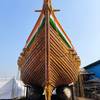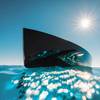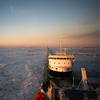Marine News' Top Boats of 2021
Sea Change - America’s first hydrogen powered ferry
SWITCH Maritime’s new 70-foot passenger ferry Sea Change is navigating uncharted waters as the United States’ first zero-emissions, hydrogen fuel cell-powered, electric-drive ferry.
The pioneering aluminum newbuild, constructed by Bellingham, Wash. shipbuilder All American Marine, Inc. (AAM), has been completed and was launched this summer, though permitting of hydrogen fuel systems for maritime vessels is still being worked out with the U.S. Coast Guard.
“Legislation and laws for passenger safety did not exist yet for this type of vessel. So, working hand in hand with the Coast Guard to create a set of rules to streamline this in the future was a necessary challenge to promote the adoption of any new technology,” said AAM president and COO, Ron Wille.
The project is funded by private capital from SWITCH, an impact investment platform aiming to build a fleet of exclusively zero-carbon maritime vessels. “By working closely with the U.S. Coast Guard, with innovative technology partners, and with best-in-class shipyards such as All American Marine, we can make the transition to decarbonized shipping a reality today,” said Pace Ralli, cofounder and CEO of SWITCH. “We don’t have to wait.”
The first-of-its-kind Sea Change is equipped with a hydrogen fuel cell power package provided by Zero Emissions Industries (formerly Golden Gate Zero Emission Marine), comprised of 360 kW of Cummins fuel cells and Hexagon hydrogen storage tanks with a capacity of 246 kg. This system is integrated with 100 kWh of lithium-ion battery provided by XALT and a 2x 300 kW electric propulsion system provided by BAE Systems. The vessel design originates from Incat Crowther, and the construction supervision and management is led by Hornblower Group.
The USCG Subchapter T vessel has capacity for 78 passengers and can be operated by a crew of two. The vessel includes ramps to the bow and side loading gates to provide access for people with disabilities. The bow utilizes a standard bow radius for use in many U.S. cities, and an elevated wheelhouse affords excellent visibility over bow loading operations. Sea Change can reach a top speed of 20.5 knots.
AAM’s Wille said he believes hydrogen fuel cell technology will leapfrog traditional diesel and hybrid-electric propulsion methods as the most beneficial for maritime applications. “There are a number of reasons why we see this pivot, but the main reason is basically it’s both transportable and has very high energy density. Hydrogen has more power and weighs significantly less than other forms of energy. Li-on batteries are roughly 50 times as heavy as diesel fuel. This makes it very difficult to go either far (or fast) in a boat running on batteries.
“On a pound for pound basis, hydrogen has nearly three times the energy of diesel fuel and can also be used more efficiently in fuel cells than diesel in internal combustion engines.
“Simply put, hydrogen can be compressed into a much smaller space and weighs far less than both its battery or diesel equivalent. Therefore, in the same amount of space taken up by a battery bank or diesel tank, you can have much more hydrogen and travel much further.
“It’s also modular and scalable, with a number of fuel cells generating energy, if one happens to go offline, it can easily be swapped while the others continue to do the work. It doesn’t result in the need for an entire engine replacement. It’s much simpler and all made up of components and systems that have been used before and are proven in the transportation sector.”
Wille noted that passenger vessels are “an ideal starting point” for the maritime industry’s adoption of zero-emissions technologies. “The short routes, consistent schedules, relatively low energy requirements made ferries an ideal candidate,” he said. “[Sea Change] provides a unique quiet passenger experience, no diesel engine noise or fumes.
“It’s a beautifully built, modern looking passenger ferry to go alongside it being the first of its kind in the world fully run on hydrogen fuel cell technology. Complete with reusable bottle filling stations, top of the line seating, bike racks, and a state-of-the-art pilot house, the hydrogen fuel cell propulsion system is really what stands out. And the fact that this system is modular and scalable, is really exciting.”
But Wille believes Sea Change and its groundbreaking zero-emissions power systems are just the tip of the iceberg. “This vessel is the first step towards decarbonizing the maritime industry. This technology will have a global impact. This isn’t just about a ferry. This is about a viable future for the maritime industry. It’s about not only the potential for cargo ships, it’s also about an increased awareness in public transport, daily work commutes and ultimately, the passenger experience. This technology will directly affect future passenger ferries and water taxis, and your commute to work in the future by providing a quieter and sustainable commute.”
This project has received municipal support including a $3 million grant from the California Air Resources Board (CARB), administered by the Bay Area Air Quality Management District (BAAQMD), that comes from California Climate Investments, a California statewide initiative that puts billions of Cap-and-Trade dollars to work to reduce greenhouse gas emissions, strengthen the economy, and improve public health and the environment – particularly in disadvantaged communities. Additionally, the project received the first ever loan guarantee under BAAQMD’s Climate Tech Finance program, which seeks to reduce greenhouse gases by accelerating emerging climate technologies. In partnership with the California Infrastructure Economic Development Bank and the Northern California Financial Development Corporation (NorCal FDC), the Climate Tech Finance team led a technology qualification and greenhouse gas analysis that deemed SWITCH eligible for a loan guarantee. This loan guarantee supported SWITCH in securing a $5 million construction and term loan with KeyBank, which enables SWITCH to bring the project to completion.
SSG Michael H. Ollis - First in a new class for a New York City icon
There’s a lot to like about the newest vessel commissioned by the New York City Department of Transportation’s (NYCDOT) iconic Staten Island Ferry. The state-of-the art 320-foot, 4,500-passenger SSG Michael H. Ollis commissioned in October sports the classic design features of the instantly recognizable the Staten Island Ferry fleet, but it’s updated throughout for improved comfort, safety and efficiency.
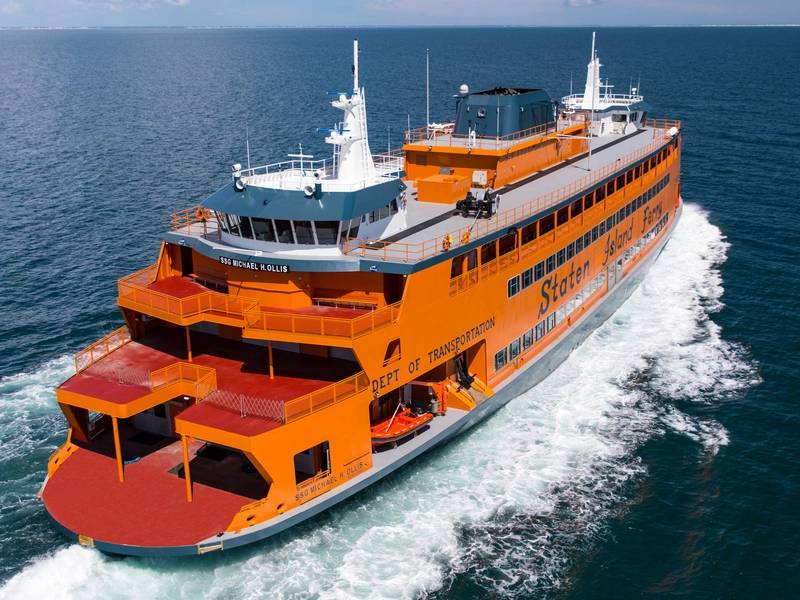 SSG Michael H. Ollis (Photo: Eastern Shipbuilding Group)
SSG Michael H. Ollis (Photo: Eastern Shipbuilding Group)
Named in honor of U.S. Army Staff Sgt. Michael H. Ollis, a Staten Island native who was killed shielding fellow soldiers from a suicide bomber in Afghanistan in 2013, the newbuild is the first in a series of three Ollis class ferries designed by Elliott Bay Design Group (EBDG) and built by Eastern Shipbuilding Group for Staten Island Ferry. “The Staten Island Ferry is an iconic transportation vessel recognized around the globe. For [the new ferry class] to honor one of our fallen heroes makes it even more special,” said Joey D’Isernia, President of Eastern Shipbuilding Group.
According to Eastern, the new ferries are larger, reflect modern technology and will operate more safely in extreme weather conditions. They feature new customer-service amenities such as more comfortable seating and phone-charging outlets and an oval upper-deck promenade that will for the first time serve as an outdoor walking track for riders.
John Waterhouse, chief concept engineer at EBDG, said a key priority when designing the Ollis class was to ensure the new ferries interface seamlessly with existing terminals to ensure that the service maintains its “brisk schedule”. In addition, the new ferries were designed with a number of “resiliency features” in mind, as in the wake of 9/11 and Superstorm Sandy the vessels would be used, if necessary, to help evacuate New York City. According to Waterhouse, part of this resiliency is the Voith Schneider propulsion units, which allow “a great deal of maneuverability and control of the vessel when coming into places that might not be its normal dock.” The new vessels also feature side doors so that they can load passengers alongside instead of solely through the ends of the ferry.
Each ferry features four ABS Electro-Motive Diesel (EMD) L12ME23B at 750 rpm EPA Tier 4 marine propulsion engines with two engines powering one ABS Reintjes DUP 3000 P combining gear and one ABS 36 RV6 ECS/285-2 Voith Schneider Propeller at each end of the vessel. Power generation is provided by three ABS, EPA Tier 3 marine continuous duty diesel generator sets, Caterpillar C18 driving 480 V, 60 Hz, 3-phase generators rated at 425 kW at 0.8 P.F. at 1,800 rpm.
Susquehanna - The latest and greatest from a pilot boat class that’s tried and true
A winning recipe from Gladding-Hearn Shipbuilding, Duclos Corporation, has made the Chesapeake class one of America’s most popular pilot boats.
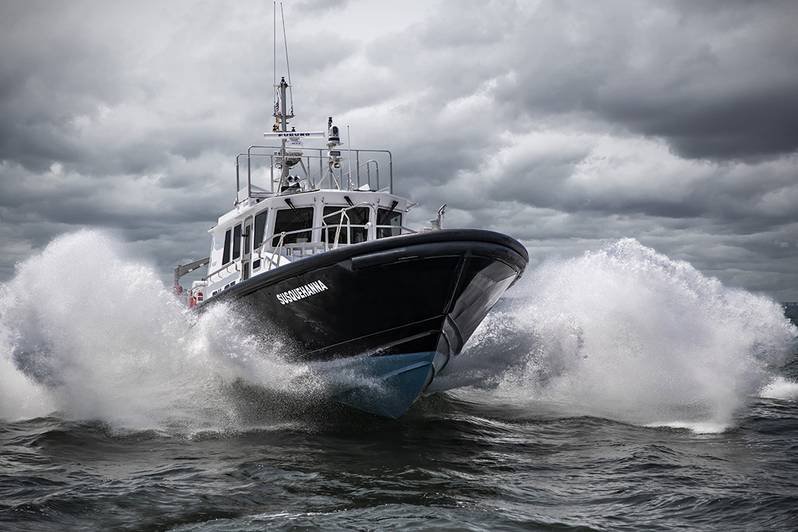 Susquehanna (Photo: Gladding-Hearn Shipbuilding)
Susquehanna (Photo: Gladding-Hearn Shipbuilding)
Since the series was introduced by the Somerset, Mass., shipyard in 2002, more than 20 have been delivered to 12 pilot associations throughout the United States, including the Susquehanna recently handed over to the Association of Maryland Pilots. In fact, Susquehanna is the fourth Chesapeake launch delivered to the Maryland Pilots, who were one of the original adopters of the design when it took delivery of Patapsco in 2002. That first vessel, by the way, is still in service and running strong.
Susquehanna is the latest greatest of the tried and true Chespeake class, which has evolved thanks to a large number of small incrementaltweaks and changes through the years, said Peter Duclos, Gladding-Hearn president and business development director. “The Chespeake class is current and valid today because we’ve continued to make better. A lot of things are similar, but it’s not the same boat that it was in 2002,” Duclus explained. “The result of all these changes is that the boat is faster yet burns less fuels, and it’s heavier, more comfortable and capable.”
With a deep-V hull designed by Ray Hunt Design, the new all-aluminum Susquehanna measures 52.6 feet overall, with a 16.8-foot beam and a 4.8-foot draft. Powered by twin Volvo Penta D16, EPA Tier 3-certified diesel engines, each producing 641 Bhp at 1,800 rpm, the vessel’s top speed is over 26 knots. The engines turn five-blade Bruntons NiBrAl propellers via ZF500-1-A gear boxes. A Humphree interceptor trim control system, with its Automatic Trim Optimization, is installed at the transom. The launch is equipped with a 12kW Northern Lights genset and 100% LED lighting.
The vessel’s wheelhouse, with a small trunk, is installed amidships on a flush deck. With electrically heated forward-leaning front windows, the wheelhouse is equipped with five NorSap shock-mitigating reclining seats, a baggage rack and control console. The forecastle includes a Porta-Potty, split upholstered settee/bunk, lockers for tools and safety gear safety gear and a custom immersion suit rack. The vessel’s interior is heated and cooled by two 16,000 Btu reverse-cycle HVAC units, in addition to a 2,000-watt 240 VAC heater in the wheelhouse and in the forecastle.
Outside the wheelhouse are heated side-decks and handrails to prevent ice accumulation. An aft ladder leads to hinged boarding platforms on the roof. A control station is at the transom, along with a hydraulically powered J-Basket rescue system, for pilot rescue operations.
Spindletop - Largest pilot boat in the U.S.
With a long, dark deep-V hull and its aquamarine coloring up top, Sabine Pilots’ newest launch Spindletop delivered in mid-March is definitely a head-turner. But perhaps most attention grabbing is the vessel’s dimensions: 90 feet long and 23 feet wide.
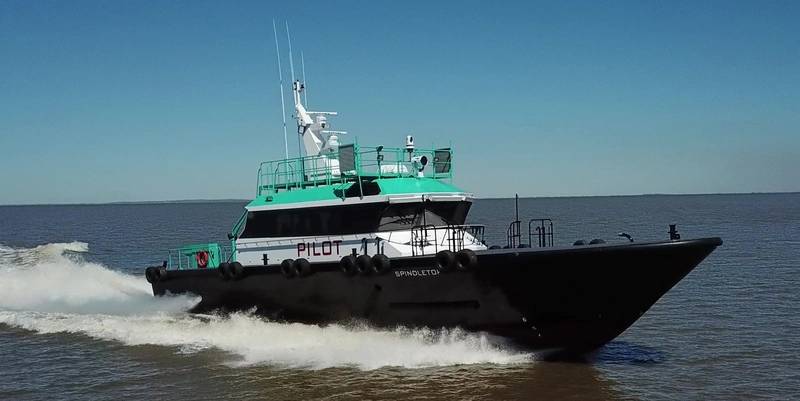 Spindletop (Photo: Breaux’s Bay Craft)
Spindletop (Photo: Breaux’s Bay Craft)
“Spindletop is the largest all-aluminum pilot vessel built in the U.S.,” said Roy J. Breaux, Jr., president of Breaux’s Bay Craft, the Loreauville, La. shipyard that built the groundbreaking vessel. “When Sabine Pilots came to Breaux’s Bay Craft to have this vessel built, they requested a Gulf of Mexico Bottom with a plush and comfortable interior, fuel efficiency and stability in bad weather conditions.”
The launch was designed by Breaux’s Bay Craft in partnership Madisonville, La. naval architecture firm C.FLY Marine Services. “The overall size of the vessel gives the pilots more comfort with the capabilities of seating 14 pilots, one navigator and captain in Hy Back NorSap reclining seats and sleeping accommodations for four with full galley,” Breaux said. The vessel features a three-ton water cooled air conditioning system for the pilothouse and another two-ton water cooled AC system for the lower accommodation, which includes two double bunk staterooms, settee seating area and a full head with shower.
“The vessel’s speed, fuel efficiency and stability also make it unique,” Breaux said, noting Spindletop the first quad screw jet propulsion pilot vessel built in the U.S.” Powered by four Scania DI16-82M engines (800 HP at 2,100 RPM) with Twin Disc MGX 5146 gears, Centek Water lift mufflers and quad Hamilton HM461 waterjets, Spindletop cruises ay 27 knots with a top speed over 30. Its Ecospeed underwater hull coating offers improved hydrodynamic characteristics that help to enhance performance and save fuel.
Breaux’s Bay Craft has been building pilot boats since the early 1970s, but Spindletop is just its second with its new generation deep-V bottom. Having run for more than 38,500 nautical miles (as of October 20), Breaux said Spindletop’s performance has been exceptional. “The vessel has been in service in adverse weather conditions, including 8- to 10-foot seas, and has exceeded and outperformed all expectations,” Breaux said
“We went to Breaux for a custom-built pilot boat that would maximize safety and comfort for our 17 mile stretch in the Gulf of Mexico, and could not be happier with our choice,” said Capt. Kenneth Leslee Hurd, boat superintendent for Sabine Pilots. “The Spindletop with its four Hamilton jets coupled to the 4,800 HP Scania engines, Humpree active ride trim tabs, and Breaux’s new hull design she cuts thru our constant 3- to 4-foot chop that we run on a daily basis with ease. Another great feature from Hamilton is their new AVX (boat mouse) system that allows the operator to maneuver the vessel with ease in restricted areas.”
Hurd said operator visibility during pilot transfers was a main priority when designing the new launch, adding that Spindletop’s heated fritted glass windows allow the operator 360 degrees of unobstructed views at all times.
For pilot transfer operations, Spindletop has port and starboard boarding platform on both the bow and pilothouse. A combination of DB 510 D bumpers and aircraft tires surround the perimeter of vessel. For rescue assist, there’s a custom-built rescue platform by SeaLift located on transom with 24V hydraulic unit, plus a transom jib pole with 120V electric winch.
Hurd expects Spindletop—Sabine Pilots’ fifth Breaux built pilot boat—will be disembarking and delivering pilots to ships safely for many years to come.
Rachael Allen - A tug with autonomous capabilities
Foss Maritime’s newest vessel is the first U.S.-flag harbor tug to integrate autonomous systems in real-world commercial operations.
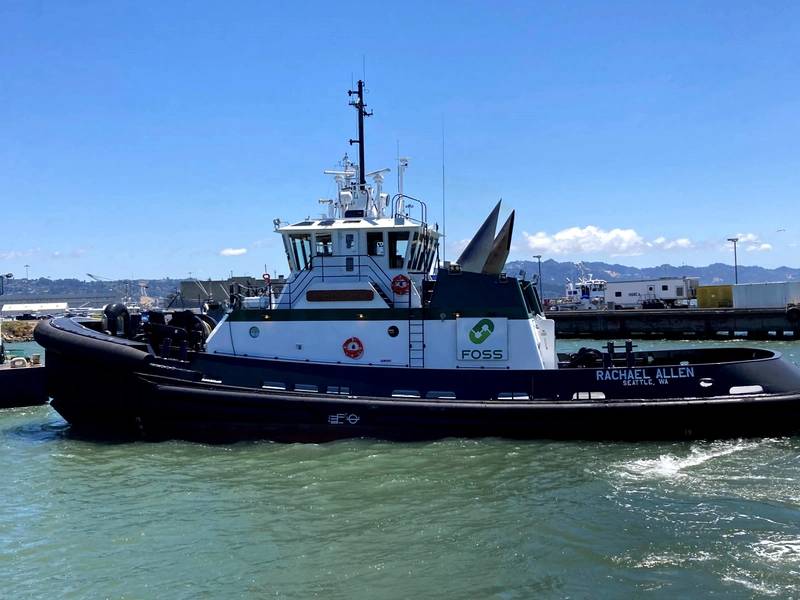 Rachael Allen (Photo: Foss Maritime)
Rachael Allen (Photo: Foss Maritime)
Delivered in June, the newly built 90-ton bollard pull Rachael Allen—the fourth in a series of ASD-90 Z-drive tractor tugs built at Nichols Brothers Boat Builders, in Freeland, Wash.—features Sea Machines Robotics’ SM300 autonomous-command and -control system. The system’s capabilities include transit autonomy, as well as remote access of the tugboat’s onboard machinery, a feature that allows personnel to manage and support operations from anywhere on board the vessel or from shore. Navigation obstacle detection and avoidance capabilities also come standard.
Tapping into the remote command and control capabilities, Foss will use its existing Fleet Monitoring Center personnel to monitor the tugboat’s systems and operating domain via streaming video and sensor data. According to Foss and Sea Machines, the system enables an extra set of eyes and hands to have access to vessel command and control, allowing Foss and the Rachael Allen crew to maximize productive time, safety and crew welfare
“While we are not working on a fully autonomous tug, [the Sea Machines systems] allow our crews to use autonomous features to make their jobs safer. Our mariners are the key to our success, and we believe the Sea Machines products will help them carry out their day to day operations,” said Will Roberts, president, Foss Maritime.
The Rachael Allen has been delivered with the SM300 and supporting hardware fully integrated, but the capability of the technology will be activated in stepped phases over the course of six to nine months to ensure full visibility and acceptance from all operational stakeholders. “Our work toward integrating the autonomous controls . . . continues with our partners at Sea Machines, the U.S. Coast Guard and ABS,” Roberts said. “As a safety enhancement that incorporates new and novel technology, we are testing out a tool to support our crews, which comes from a system processing digital information to enhance safety of navigation. We are excited about the tools this system brings to our mariners in their service of our customers. We will work closely with regulatory agencies and third-party auditors to thoroughly vet the system as we continue to move toward full operational use of the SM300 on board.”
Michael G. Johnson, Sea Machines founder and CEO, said, “While our space has seen a number of government-innovation backed prototype initiatives for autonomous tugs in Europe, Japan and Singapore, it’s notable that Foss is launching the first commercially funded project in U.S. waters.
“Our technology has been in use aboard commercial vessels around the world for nearly three years and is backed up by thousands of hours of testing and validation. This is yet another real-world example of how Sea Machines autonomy is reshaping the way work is being done by vessel crews on the water.”
Sea Machines noted the Rachael Allen project marks its first installation of an autonomy system on a vessel over 5,000 horsepower. Designed by Jensen Maritime Consultants, the 100- by 40-foot tractor tug will be able to escort the largest tankers and containerships calling the U.S. West Coast ports that it will serve. The vessel is outfitted with two MTU Series 16v4000M65L EPA Tier 4 main engines, producing 6,866 horsepower and coupled to Kongsberg US255 azimuth thrusters.
The MTU selective catalytic reduction (SCR) system provides optimization of the engine delivering improved efficiencies, fuel consumption is reduced by 8% at full power and 14-22% over a wider operating range compared to previous MTU engines in this power range. The MTU engine and SCR are designed with a high focus on noise reduction, standard features such as resilient mounting, turbocharger air intake silencers and the SCR insulation and noise abatement, all combined to produce noise levels throughout the vessel without any traditional exhaust silencers. The MTU engines are also equipped with MTU Go, a MTU digital monitoring system and service that allows continuous monitoring of the engines including all engine parameters and alarms, with trending and broadcast of engine alarms through the MTU Go App.
Rachael Allen is outfitted with Mackay Marine Electronics, and towing equipment consists of a Markey DEPGF-52R winch with 750 feet of 10-inch synthetic line on the bow and a Markey DEPC-32 stern winch with 250 feet of 6.5-inch circumference line on the stern. The tug is built to U.S. Coast Guard Subchapter “M” regulatory standards, with ABS loadline certification and UWILD notation.
Bowling Green - A high-power, triple-screw towboat
Belle Chasse, La. shipbuilder C&C Marine and Repair this summer delivered the new towboat Bowling Green to Kirby Inland Marine, L.P. The newbuild—the second in a three-boat series for Kirby, delivered six months after the first vessel Scarlett Rose Furlong —will operate it under a long-term lease from Hines Furlong Line.
 Bowling Green (Photo: C&C Marine and Repair)
Bowling Green (Photo: C&C Marine and Repair)
The 6,600-horsepower triple-screw towboat measures 170 feet by 50 feet with the pilot house eyeline measuring at 39 feet, three inches. Designed by CT Marine based in Portland, Maine, the vessel is powered by three Cummins QSK60-M main engines, provided by Cummins Mid-South, that are paired with three Reintjes WAF 1173 H/V reduction gears, provided by Karl Senner, LLC. The service power is provided by three Cummins QSM11-DM, 275 kW generators, and the conventional steering system HPU was provided by EMI Marine. The towboat is outfitted with three 100” diameter stainless-steel fixed pitch propellers, provided by Sound Propeller Systems, Inc, and features double steering rudder system. The accommodations include a total of 12 beds (11 crew, plus one guest), and the vessel’s design includes a floating, spring mounted superstructure for additional crew comfort.
“We wanted the durability of a conventional vessel with both stellar northbound and southbound performance,” Hines Furlong Line president Kent Furlong told Marine News. “At the same time, we fully acknowledge the superior maneuverability that Z-drives offer. With all of this in mind, we are convinced that this conventional, kort nozzled setup with the double steering rudder arrangement gets us the best of both worlds.”
Gretchen V. Cooper - New towboat is clean and green
The U.S.’ first linehaul towing vessel powered by Tier 4 Caterpillar high-speed engines with selective catalytic reduction (SCR) was built by Blakeley BoatWorks (BBW) and is now operated by Cooper Marine and Timberlands (CMT).
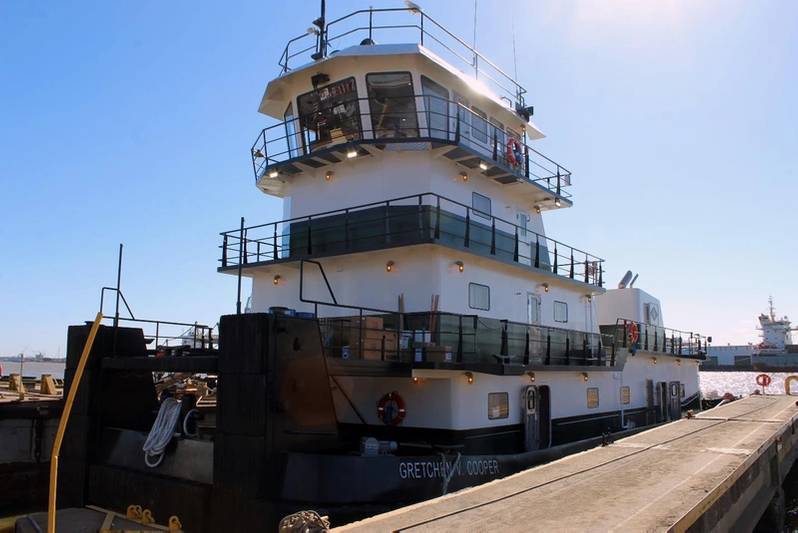 Gretchen V. Cooper (Photo: CMT)
Gretchen V. Cooper (Photo: CMT)
In March 2021, Blakeley BoatWorks completed construction of Gretchen V. Cooper, a state-of-the-art, Tier-4 inland linehaul tow boat. This 3,400-horsepower vessel is 110-feet long, 33-feet wide and expands CMT’s fleet to 20 vessels.
The vessel is powered by two Caterpillar C3512E 3,400 HP Tier IV diesel marine engines operating at 1,800 RPM and coupled to Twin Disc MGX5600 gears. The engines significantly reduce emissions of particulate matter, or black soot and nitrogen oxide, while also saving fuel. Thompson Caterpillar also supplied electrical power with two Caterpillar C4.4 Tier III generators with RW Fernstrum, Inc. keel coolers throughout. A pair of Southeastern Propeller four-blade stainless steel propellers provide thrust through two J & S Machine Works, Inc. 9-inch ABS Grade two propeller shafts with Cutlass shaft bearings, Thordon rudder bearings, and Kemel shaft seals. Gulf Coast Air and Hydraulics supplied the steering system for the two 9-inch main and four 8-inch flanking rudders.
“Our customers expect Blakeley BoatWorks and Cooper Marine & Timberlands to drive industry innovation, and our building and operating one of the industry’s most environmentally friendly towboats marks our unwavering commitment to always exceed their expectations,” said Angus R. Cooper III, President, Cooper/T. Smith, parent company to both BBW and CMT, headquartered in the port of Mobile, Ala. “Naming a boat after my wife Gretchen meant that we couldn’t just settle for building a standard towboat, and therefore the Gretchen V. Cooper will be one of the most powerful towing vessels operating on the Tennessee-Tombigbee Waterway and will lead the way for a new industry standard for reduced emissions on towboats.”
SAFE 44 Patrol Boat - A versatile patrol boat
The SAFE 44 Full Cabin – Inboard designed and built by Bremerton, Wash.-based SAFE Boats International for the U.S. Department of Defense serves as a command and control platform and performs a variety of military and scientific support missions domestically and around the world.
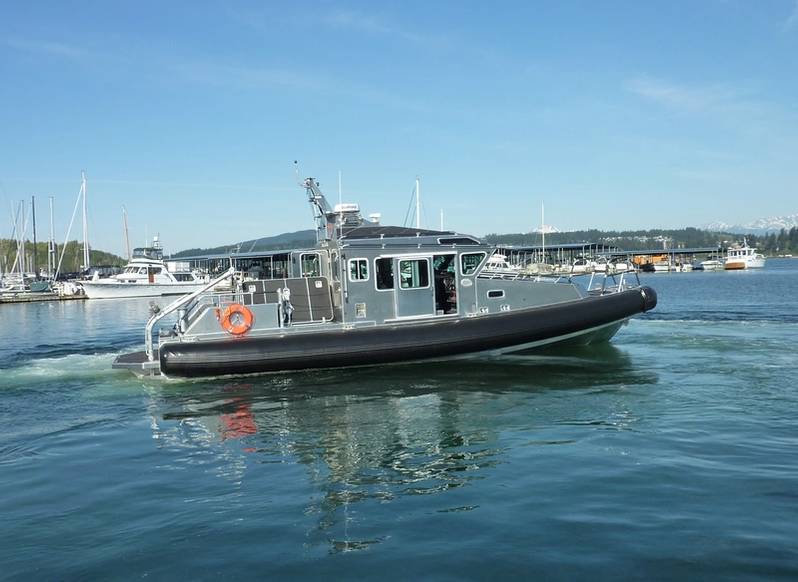 SAFE 44 Patrol Boat (Photo: SAFE Boats International)
SAFE 44 Patrol Boat (Photo: SAFE Boats International)
The ample cabin configuration with four shock-mitigating seats allows for freedom of movement and a comfortable and safe ride in rough seas. The installed Seakeeper enhances vessel stability and reduces crew fatigue. The onboard galley and head provide crew habitability during extended time away from port. The SAFE 44 Full Cabin – Inboard is just as at home in protected, inland waters as it is in rougher, offshore seas. The sturdy hull, extreme duty reinforced (XDR) collar and other standard safety features offer peace of mind unapparelled in the industry.
The SAFE 44 Full Cabin – Inboard is powered by dual Cummins QSM11 inboard diesels, with ZF 325-1 gears and drivelines as well as twin Hamilton HTX30 waterjets with 24VDC electronic controls. It is also equipped with a Westerbeke 7.6 kW diesel generator
It is equipped with a Seakeeper 7HD and Zipwake Dynamic Trim Control System, plus the vessel features a wide beam design for solid performance in heavy seas. A spacious, climate-controlled cabin offers good crew comfort and safety. The Full Cabin – Inboard’s design makes it well-suited for conducting a variety of missions including command and control, general patrol, and search and rescue operations in both inland, coastal, and offshore waters.
Fire Boat 2 - A “next-generation” fireboat
Fire Boat 2, delivered to Orange Beach Fire Rescue in Alabama this summer, is the first 38 Defiant NXT next-generation welded-aluminum monohull pilothouse vessel, a new model based on Metal Shark’s popular 38 Defiant platform. Utilizing the same proven hullform as the more than 100 legacy model 38 Defiant vessels already in operation, the new 38 Defiant NXT has an entirely new topsides arrangement designed by Metal Shark’s in-house engineering team.
 Fire Boat 2 (Photo: Metal Shark)
Fire Boat 2 (Photo: Metal Shark)
“Redesigning one of our best-selling models at the peak of its popularity was not a task we approached lightly, but through our efforts we made significant improvements to an already outstanding platform,” said Metal Shark CEO Chris Allard. “Orange Beach Fire Rescue’s new 38 Defiant NXT fireboat and the multiple other fireboats now in production are a direct result of our goal to consistently offer the industry’s most advanced designs through ongoing product evolution.”
Orange Beach Fire Rescue’s new 38 Defiant NXT is powered by twin 550-HP Cummins QSB 6.7 inboard diesels mated to Hamilton HTX30 waterjets with Blue Arrow control system via Twin Disc MG 5065 SC transmissions. This configuration enables this fully-equipped 43- by 12-foot fireboat to cruise at 30 knots and reach top speeds in excess of 40 knots while offering superb maneuverability at all speeds. The 38 Defiant NXT is available with a wide range of propulsion types and can reach top speeds of more than 50 knots when powered by triple outboards.
For firefighting, the Orange Beach fireboat delivers a flow rate of 3,000 GPM, with twin 1,500 GPM Darley fire pumps driven via PTO from the main engines. Each pump draws from its own dedicated in-hull sea chest, feeding a central manifold with crossover capability, which in turn supplies the entire system. From the fire control station at the port helm, flow is directed as desired via electronically-actuated valves. The vessel is equipped with a remote-operated Elkhart Scorpion EXM electric rooftop monitor, two Elkhart Copperhead manually operated monitors aft, dual handline outlets, and a 5-inch Storz connection.
Leonard E. Redon - A fireboat with enhanced capabilities
The new 38-foot,10-inch fireboat Leonard E. Redon entered service for the Rochester Fire Department in Upstate New York in June, greatly enhancing the agency’s on water firefighting and rescue capabilities.
 Leonard E. Redon (Photo: Moose Boats)
Leonard E. Redon (Photo: Moose Boats)
Among key features a roof monitor, a cockpit monitor, a 5-inch large diameter hose Storz discharge, and the ability to pump over 1,500 gallons per minute, according to California-based boatbuilder Moose Boats. The new boat also has an extended walk-around cabin configured with three shock-mitigating crew seats, an incident command/navigation station, an 84-inch patient bench with EMS storage below, and an integrated deck level head enclosure. Weather-tight deck boxes on the fore deck and aft deck will house firefighting foam and the additional valves, nozzles, tools and hardware necessary to respond to a wide range of fire and rescue scenarios. Capable of speeds up to 34 knots, the vessel is powered by Cummins QSB 6.7L (850mhp at 3,000rpm) with Twin Disc 5075SC gears and Hamilton HJ292 waterjets.
Ken Royal, sales VP at Moose Boats, said, “The catamaran is an extremely stable working platform with a very wide deck plan offering much larger cabin configurations with deck level walk around capabilities. The wide separation between the two catamaran demi-hulls positions units further apart than a mono-hull, resulting in a very high level of maneuverability when cross vectoring jet streams. The reduced wetted surface area of the catamaran hull increases efficiency and minimizes wake at planning speeds with considerably less draft than a mono-hull.”
Huntington Beach - Capable craft for swift assists
The 30-foot rigid hull inflatable boat (RHIB) Huntington Beach, built by Silver Ships, has been custom designed and outfitted uniquely for use as an offshore marine assist and tow vessel supporting operations at TowBoatU.S. Long Beach. To extend range, the client transitioned from more traditional fiberglass boats to the Silver Ships AM800 platform. The end result is a significant increase in response range with a commensurate reduction in response time.
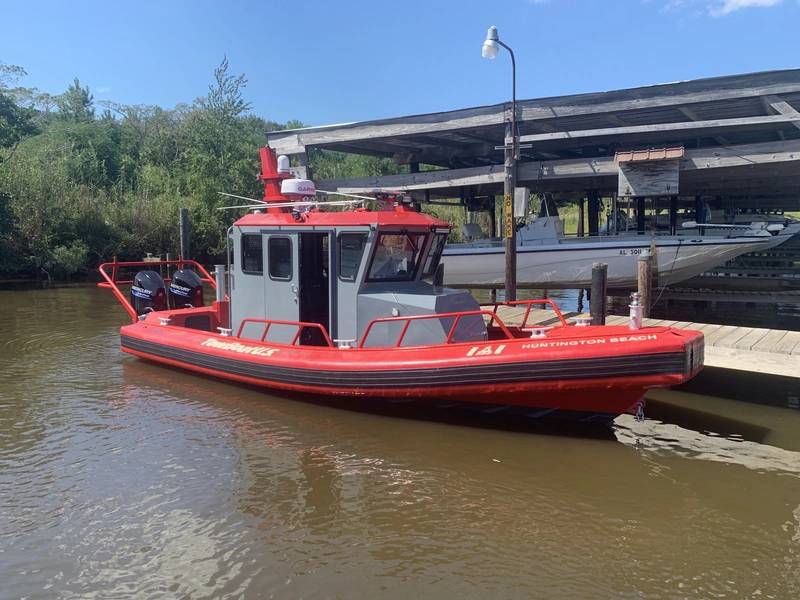 Huntington Beach (Photo: Silver Ships)
Huntington Beach (Photo: Silver Ships)
Powered by twin Mercury 300 HP SeaPro outboards, the RHIB is capable of speeds greater than 45 knots. Built with underwater seams that are continuously welded inside and outside and using 5086 H32 grade aluminum plates, with each bottom plate being a minimum ¼-inch thick, the AM800 vessel features an extended beam and full walk around cabin. According to Silver ships, it affords not only a safer platform to work from, but stores the capability to not only tow, jump start or drop fuel, but also perform salvage work with the on-board equipment. This equipment includes lift bags, air tanks and a gas-powered de-watering pump.
This workboat very recently helped save the lives of two mariners clinging to their submerged vessel 17 miles off the coast. “The AM800’s ability to complete the tasks of multiple boats has provided our customers’ company benefits beyond the scope of what they intended and the ability to engage in missions they did not expect to be executing,” said Dave Hunt, business development specialist at Silver Ships.
Atlantic Endeavor - Among a new class of Jones Act CTVs
Atlantic Wind Transfers’ (AWT) newest crew transfer vessel, Atlantic Endeavor, constructed by Rhode Island shipbuilder Blount Boats and delivered in January, is just the third purpose-built CTV in the Jones Act fleet, which is needed to support the burgeoning U.S. offshore wind market for decades to come.
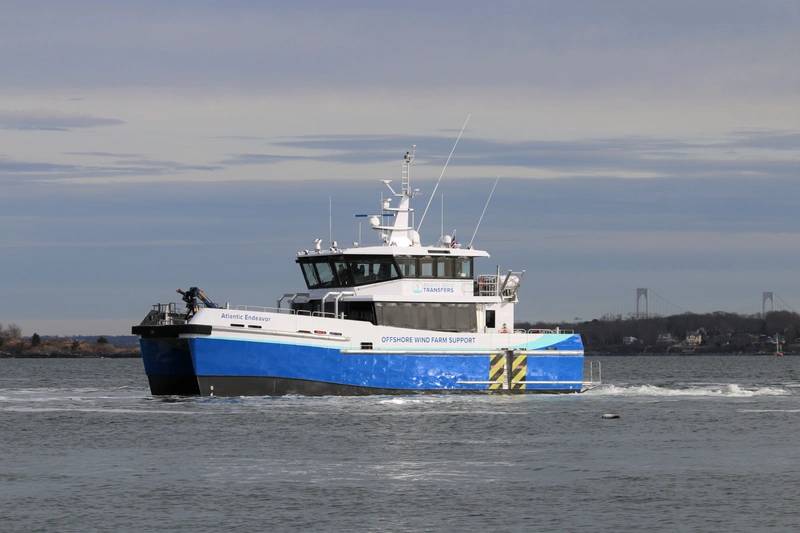 Atlantic Endeavor (Photo: Blount Boats)
Atlantic Endeavor (Photo: Blount Boats)
The specialized model of the Chartwell 24, designed by U.K.-based Chartwell Marine Ltd., was modified to comply with American environmental and USCG regulations. Andy Page, Managing Director of Chartwell Marine, noted several key differences between CTVs built for U.S. and European waters. For one, the underwater profile of the U.S. version has been modified to operate safely in wavelengths and swells along the U.S. Eastern Seaboard that are typically longer and larger than what’s seen in the North Sea. From a compliance perspective, the designer also considered emissions standards variances as well as U.S. legislation protecting the migration route of the protected right whales.
The 64.9-foot Atlantic Endeavor is a twin hulled aluminum catamaran equipped with quad 799-horsepower MAN engines, Cummins generators, ZF Transmissions, HamitonJet waterjets and Humphree USA Interceptors. Its service speed is 22-24 knots, with a sprint speed of 29 knots. On deck, the CTV has 10 metric tonnes cargo capacity, and it is fitted with a Palfinger crane and Nabrico anchor winch. The vessel is also equipped with a power washing and fuel transfer system.
AWT, based in Quonset Point, R.I., is the Unite States’ first owner/operator of CTVs, typically aluminum catamarans, used for transporting wind farm technicians and other personnel, and sometimes equipment, out to sites on a daily basis. Its first CTV, Atlantic Pioneer, was built by Blount Boats in 2016 and has been servicing the five 6-megawatt turbines at the Block Island Wind Farm off Block Island, R.I.
Atlantic Endeavor is based out of Virginia’s Hampton Roads region under AWT’s long-term O&M CTV contract with Dominion Energy to support its Coastal Virginia Offshore Wind Farm (CVOW) pilot project 27-miles off Virginia Beach. Manned by two to four crew members, Atlantic Endeavor has capacity to transport up to 24 wind farm technicians.




